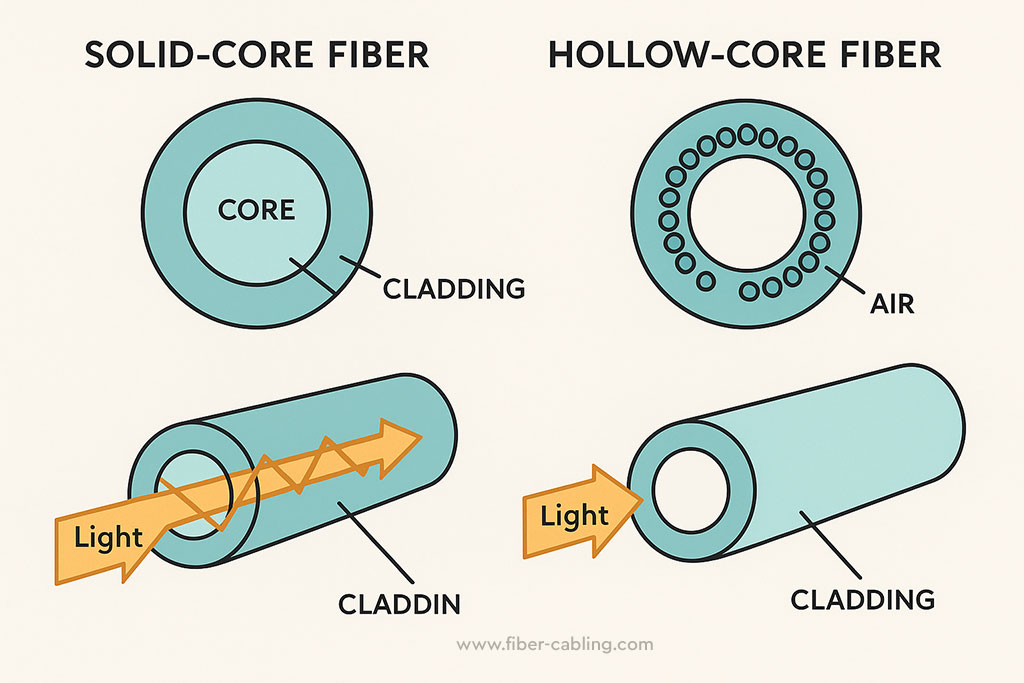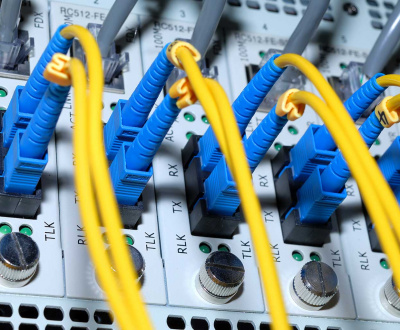Hollow-Core Fibers: Historical Evolution and Cutting-Edge Innovation
- September 15, 2025
- fiber optic cabling
Early Vision and Theoretical Foundations
The concept of guiding light through air rather than glass was introduced in the late 20th century. Early optical fibers relied exclusively on solid silica cores, which set a hard physical limit on performance. The fundamental constraint was Rayleigh scattering, an unavoidable loss mechanism in solid-core fibers. By the 1990s, researchers began exploring photonic bandgap structures, proposing that microstructured cladding could confine light inside an air core.
Key milestones included:
- 1980s–1990s: Theoretical work on photonic crystals and bandgap confinement.
- 1996: First demonstration of photonic crystal fiber (PCF) by Philip Russell’s group at the University of Bath.
- 1999–2000s: Progress in hollow-core photonic bandgap fibers (HC-PBGF), though limited by fabrication complexity and higher-than-expected attenuation.
These early trials laid the groundwork for the modern hollow-core revolution.
Hollow-Core vs Solid-Core Fiber: The Breakthrough

Traditional fibers trap light by total internal reflection in solid silica. Hollow-core fibers confine light within an air-filled central channel, using either:
- Photonic Bandgap Effect: Periodic structures block certain light frequencies, forcing them into the hollow region.
- Inhibited Coupling: Light weakly couples to cladding modes, leading to low confinement loss across broad bandwidths.
The advantage is clear:
- Light travels primarily in air, not silica.
- Nonlinear effects are reduced by an order of magnitude.
- Latency approaches the theoretical speed of light in vacuum.
- Attenuation has dropped below 0.2 dB/km in recent designs, rivaling or surpassing silica fibers.
Industrial Innovation and Recent Achievements
The last decade has transformed hollow-core fibers from academic prototypes to commercial contenders. Advances include:
- Negative Curvature Fibers (NCF): Introduced in the 2010s, they achieve wide transmission windows and simpler fabrication compared to HC-PBGFs.
- Record Low Losses: Companies like Lumenisity (acquired by Microsoft) reported hollow-core fiber losses of ~0.22 dB/km in 2020, approaching standard silica.
- Broadband Performance: Wide spectral windows now support dense wavelength-division multiplexing (DWDM), enabling compatibility with existing telecom infrastructure.
- Scalability: Novel stack-and-draw fabrication and improved preform designs are driving mass production feasibility.
Application Domains Shaping the Future
Hollow-core fibers are not incremental improvements. They redefine the limits of optical networking, opening new frontiers:
- Telecom and Data Centers: Lower latency and reduced nonlinear penalties make them ideal for high-frequency trading, cloud networking, and AI-scale data interconnects.
- Quantum Communications: Ultra-low noise transmission benefits entangled photon distribution and quantum key distribution.
- High-Power Laser Delivery: Air-guided cores prevent damage from nonlinear effects, enabling safe long-distance delivery of high-energy pulses.
- Medical and Industrial Imaging: Minimal dispersion supports ultrafast endoscopic imaging and laser machining.
Engineering Challenges Ahead
Despite progress, deployment barriers remain:
- Splicing and Connectorization: Joining hollow-core to standard silica fibers requires specialized transitions.
- Bend Sensitivity: Mechanical robustness and loss under tight bends still trail conventional fibers.
- Manufacturing Yield: Maintaining precise microstructure geometries at industrial scales is a hurdle.
Outlook: Hollow-Core as a Platform Technology
The trajectory suggests hollow-core fibers will not replace solid silica everywhere but will dominate latency-sensitive, high-capacity, and high-power applications. With major investments from cloud providers and defense sectors, the ecosystem is shifting from laboratory novelty to mainstream infrastructure.
The future lies in hybrid networks where hollow-core fibers handle critical low-latency backbones, while conventional fibers continue as cost-effective workhorses. As losses push closer to 0.1 dB/km and splicing solutions mature, hollow-core adoption will accelerate, shaping the next era of optical communication.
Fiber-Cabling.com
is Toronto’s top fiber optic design and installation provider, serving clients across Canada. We specialize in fiber layout design, supply, splicing, and testing, ensuring reliable, future-ready connectivity. With expert installations and quality materials, we deliver top-tier fiber solutions tailored to your needs. Contact us for a free consultation today!
Request a free quote
Looking to enhance your network with top-tier fiber optic solutions? Get in touch with Fiber-Cabling.com for a free consultation. Our team is ready to assist you with all your fiber optic needs, from design and installation to testing and maintenance.






